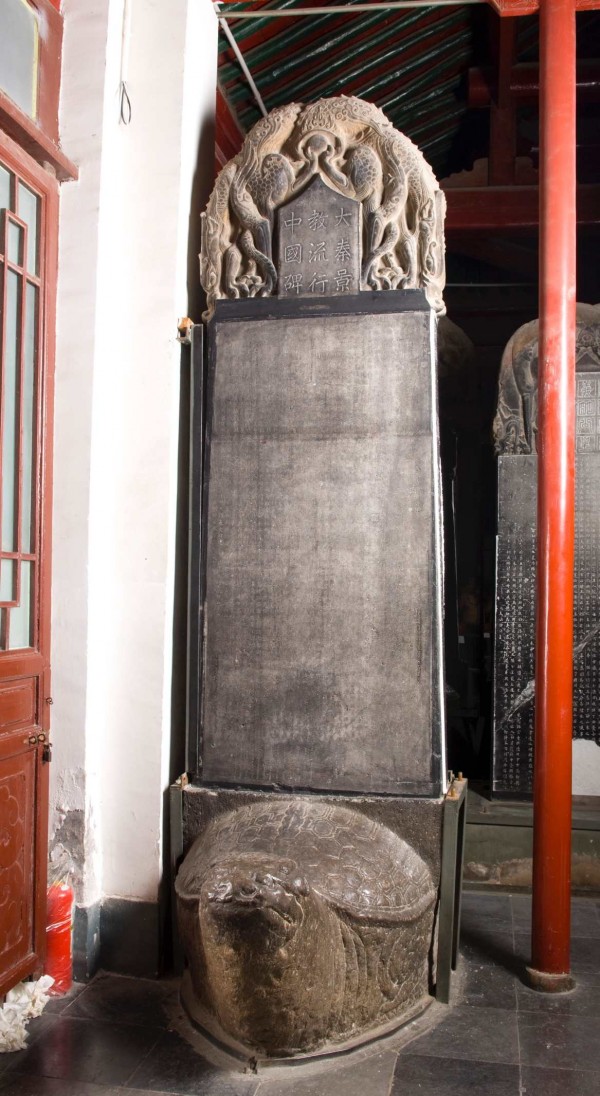
Syriac, the ancient Syrian language, on the bottom of the stele, explains the names of missionaries and local landscapes. /Photo courtesy of Xi'an Beilin Museum
ishtartv.com - news.cgtn.com
By Meng Qingsheng, Li Yang, 19-May-2019
When did Christianity first appear in China? Well, you may come across a much reasonable answer by examining the over 4,000 stone tablets at Xi'an Beilin Museum, or Stele Forest, located in northwest China's Shaanxi Province.
A much-justified answer to that question is in 635 AD during the early Tang Dynasty (618–907), the time of which was inscribed on the world famous Nestorian Stele, a
279-centimeter tall limestone block.
It's the monument that helps unravel some of the mysteries regarding Christianity and its less influential branch, Nestorianism (Jingjiao in Chinese or the Luminous Religion), which stresses the independence of the divine and human natures of Christ.
In modern times, Nestorians are represented by the Church of the East, or Persian Church usually referred to in the West as the Assyrian, or Nestorian, Church. Most of its members - numbering about 170,000 - live in Iraq, Syria and Iran.
In a sense, the Nestorian Stele epitomizes flourishing cultural exchanges in ancient time between China and Asian countries.
Based on the texts written in Chinese and Syriac, an ancient version of the Syrian language, those countries were referred to as Daqin, denoting the Byzantine Empire, or Eastern Roman Empire (395–1453), as held by mainstream scholars in China.
The stone tablet carries about 2,000 Chinese characters in total. Based on it, in the year 635, a man named Alopen came to the City of Chang'
an, the capital of Tang Dynasty, along with his fellow Syriac missionaries. Emperor Taizong of Tang sent his chancellor Fang Xuanling and other officials to welcome their arrival.
It seems Nestorianism was well-received, as soon, there were churches set up across the Tang territory. In addition, the tablet serves as a concrete proof to China's earliest celebrations of Christmas, during which it says the emperor of the time held special rituals and shared the delicious food to people who believed in Christianity.
Lu Yuan is a retired research fellow at Xi'an Beilin Museum. After working there for more than 30 years, he spent more than two years working out a 260,000-character book explaining Nestorianism in China and the Nestorian Stele. He thinks highly of the stele's significance to both the general public and academicians in evaluating the presence of Christianity in ancient China.
In his book, published in May 2009, Lu quoted Frits Holm, a Danish scholar and adventurer who came to Xi'an in 1907, and attempted but failed to take the monument to Europe, by saying that the Nestorian Stele ranks on top of the four most famous stone tablets of the world, with the other three being the Rosetta Stone of Egypt, the Mesha Stele of Jordan, and the Aztec Sun Stone of Mexico.
Lu told CGTN in an interview that when different cultures and traditions meet, they clash with each other, and then integrate, the pattern of which conforms to the trajectories of human history. In his perspective, this best explains the prevalence of Christianity in ancient China.
Echoing Lu's words, Will Chen, a museum educator working at the same Beilin Museum, explains an underlying meaning of a unique pattern on top of the tablet, which is formed by a cross, a lotus, and auspicious clouds. According to Chen, these three elements reflect the inclusion of local cultures of Buddhism and Taoism of ancient China into Christianity.
As the stone tablet was erected in 781, it sheds much light to a nearly 150-year development of Christianity in the Tang Dynasty, since Alopen came to China in 635. During an era of religious suppression by subsequent Tang emperors, the monument was buried in the year 845.
It was only rediscovered in 1625 during the Ming Dynasty. Then in 2002, considering its cultural and historical values, China decided to prohibit the famous stone tablet from attending any overseas exhibitions.

The Nestorian Stele documents a nearly 150-year history of Christianity in China's Tang Dynasty. /Photo courtesy of Xi'an Beilin Museum

Lu Yuan is a research fellow retired from Xi'an Beilin Museum about ten years ago. He is the author of several books on the Nestorian Stele and China's stone tablets. /CGTN Photo
|